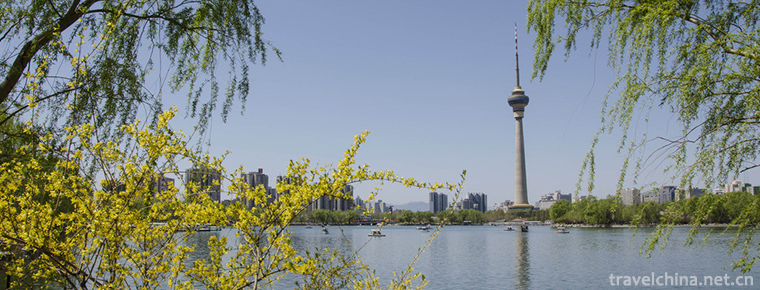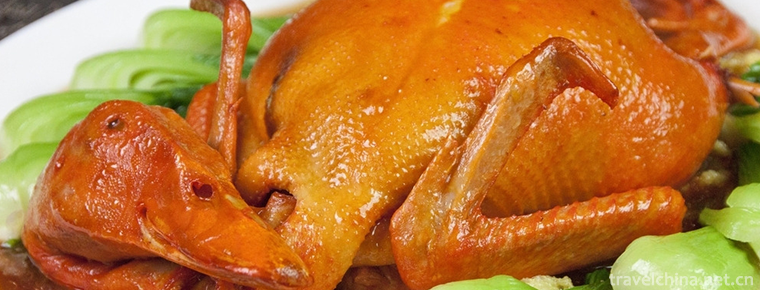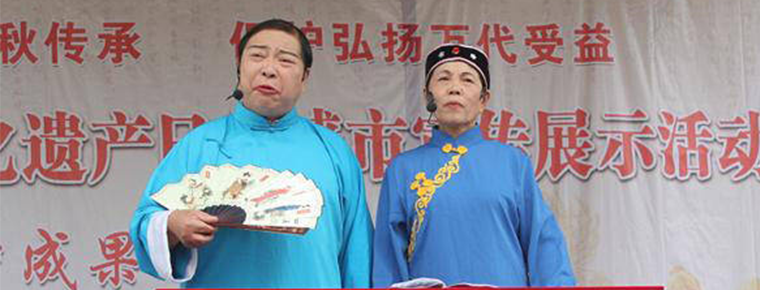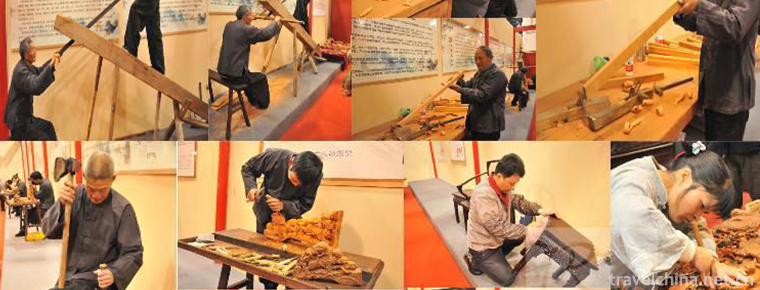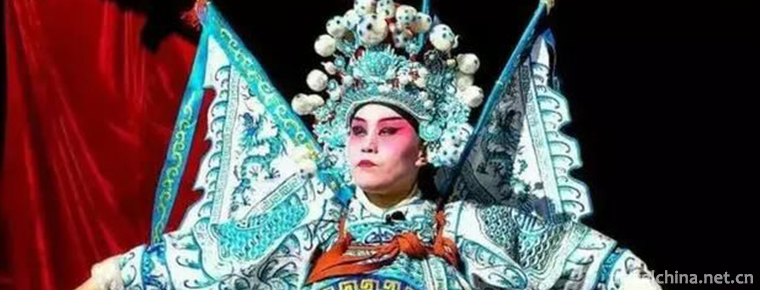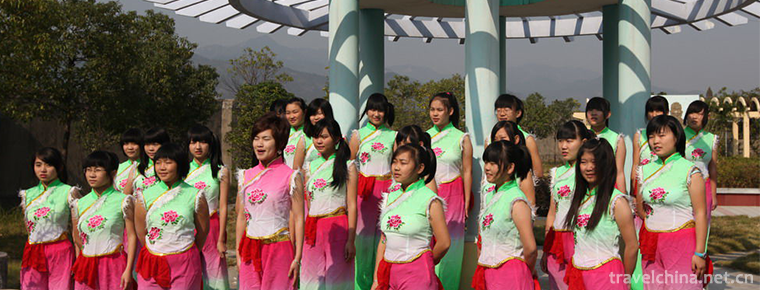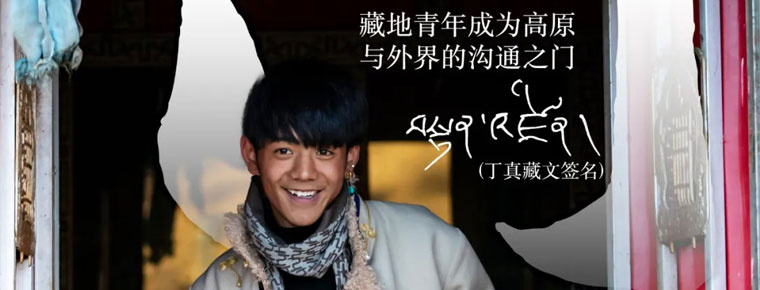Manchu Ergui wrestling
Manchu Ergui wrestling
Ergui wrestling is a traditional Manchu folk dance spread in the urban and rural areas of Longhua County, Hebei Province. It was formed in the late Qing Dynasty (around 1820 A.D.) and flourished between the late Qing Dynasty and the Republic of China. After the birth of New China, it was popularized and developed very quickly. During the Cultural Revolution, it was nearly extinct. Since 1984, after excavation, sorting and improvement of Longhua County's cultural department, it has gradually improved. It has become a cultural brand of Longhua and even Hebei Province. It has won many awards in various national competitions, which has aroused great repercussions throughout the country.
On June 7, 2008, Manchu Ergui wrestling was listed in the second batch of national intangible cultural heritage list with the approval of the State Council.
Skill
"Ergui wrestling" is a folk prop dance. The performers tie wooden wrestling props to their backs, squat their legs, wear a pair of thin-soled cloth boots with their hands upside down, and play each other's legs with their arms. With the accompaniment of the martial arts band, they perform the scene of two people's wrestling with both hands and feet. Its performance is powerful, humorous, collective performance momentum is magnificent, spectacular, highly ornamental and unique artistic charm. It combines unique props, sports and art, and has special historical, academic and research value. "Ergui wrestling" has won prizes in many national competitions, such as the national traditional minority sports games, the first international folk art festival, the first national single, double and triple dance competition, and the third national minority art festival. In June 2006, it was announced by the Hebei Provincial Government as the first batch of provincial intangible cultural heritage representatives. June 14, 2008 is a national intangible cultural heritage.
Historical evolution
"One man is worth two, hard to understand and hard to separate. If you throw yourself, you will decide the future. This is a poem about "Ergui wrestling" written by Chengde people. This legend began with the Manchu folk dance in the reign of Kangxi in the Qing Dynasty, and "fell" for more than 300 years along the way.
Ergui wrestling is not only the flower festival of Manchu people, but also a kind of sports activities. The performer is a person, but he can play two naughty children wrestling in braids by wearing cleverly made props. One person pretends to be two people wrestling, but imitates it vividly. It is difficult to distinguish the true from the false for a moment. It is funny and humorous.
The story of Kangxi's antagonism with Ao Bai is often regarded as a "selling point" in the movies and TV works, and "Ergui wrestling" is also closely related to them. At that time, Kangxi, a young man, held a wrestling competition in order to eliminate the obstacle on his way to power as soon as possible, and recruited warriors with high martial arts to help him. On May 16, 1669, the 16-year-old Kangxi finally got a chance. The warriors gathered to knock down the powerful assistant minister and the first-class official to the ground. Later, in order to celebrate Emperor Kangxi's saint-ming, the people specially transformed the scene of wrestling competition into a folk performance form of "two noble wrestling".
"Ergui wrestling" was not so called at first. Originally, it had a more externalized name, "Qiao Sumo", commonly known as "Ergui wrestling" by Chengde people. It was a performance sport with collective strength, intelligence and agility, and had been widely circulated. In the hundreds of years before the mid-1950s, this sport was quite popular in Chengde, and was often seen in Flower Fairs and festivals. Afterwards, influenced by various factors, "two ghosts wrestling" once disappeared. In the 1980s, "Ergui wrestling" was reorganized and processed by Chengde mass cultural workers and renamed "Ergui wrestling".



-
Jiang Lang Shan
Jianglangshan, formerly known as Yulangshan and Jinchunshan, is located in Shimen Town, Jiangshan City, Quzhou City, Zhejiang Province.
Views: 165 Time 2018-12-07 -
yuyuantan park
Yuyuantan Park, AAAA grade scenic spot, is located in Haidian District. East Gate is adjacent to Diaoyutai State Guest House; West to West Third Ring Road is separated from CCTV Tower; South Gate is n.
Views: 163 Time 2019-03-08 -
Eight treasures duck
Babao duck is a characteristic traditional dish in Suzhou, which belongs to Shanghai cuisine and Su cuisine. But it is best cooked by the old restaurant in Shanghai, Town God's Temple.
Views: 202 Time 2019-03-27 -
Hanchuan good books
Hanchuan Shanshu is a kind of traditional folk music which combines rap and singing in Hubei Province. Since the Qianlong period of the Qing Dynasty, it has a history of 260 years. .
Views: 126 Time 2019-05-02 -
Furniture Making Skills
Ming-style furniture making skills, local traditional handicraft in Suzhou City, Jiangsu Province, one of the national intangible cultural heritage..
Views: 193 Time 2019-05-05 -
Tongzhou Bangzi
Tongzhou Bangzi originated in more than ten counties of Dali (Gutongzhou) Center in the east of Guanzhong, Shaanxi Province. Accompanied instruments, besides drum beating, are also named for their str.
Views: 93 Time 2019-06-21 -
Tongcheng Song
Tongcheng Song is a kind of local folk song originating from Tongcheng, Anhui Province. It is a kind of local folk literature in the form of rhyme created by the local working people collectively. At .
Views: 187 Time 2019-06-21 -
Traditional craftsmanship of moon cakes
Guo Dulin Jin-style moon cakes are Shanxi specialty. They are simple in shape, mellow in taste, crisp and refreshing, sweet but not greasy. They are famous for their crispness, delicacy, sweetness, me.
Views: 192 Time 2019-07-16 -
Beijing Wuzi University
Beijing Wuzi University is a public institution of higher learning which is characterized by logistics and circulation, based on economic disciplines, with management disciplines as its main branches,.
Views: 313 Time 2019-09-06 -
About Ding Zhen Video
In November 11th CCTV news and Oriental tiktok were put on a short video of the tremble. Ding Zhen, the "sweet boy" in the video, triggered a phenomenal network event with a transmission volume of more than 5 billion times. At the same time,.
Views: 136 Time 2020-12-06 -
Yibin economy
In 2019, Yibin City will realize a GDP of 260.189 billion yuan, an increase of 8.8% over the previous year in terms of comparable prices. Among them, the added value of the primary industry was 27.764 billion yuan, an increase of 2.9%; the add.
Views: 282 Time 2020-12-18 -
Guangan economy
In 2019, the GDP of Guang'an City will reach 125.04 billion yuan, an increase of 7.5% over the previous year (the same below). Among them, the added value of the primary industry was 20.43 billion yuan, an increase of 2.8%; the added value of the secon.
Views: 355 Time 2020-12-19

